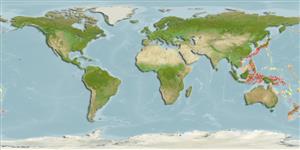分類 / Names
共通名の | 類義語 | Catalog of Fishes(部類, 種) | ITIS | CoL | WoRMS | Cloffa
Environment: milieu / climate zone / depth range / distribution range
生態学
海 深海魚; 深さの範囲 250 - 300 m (Ref. 28016). Deep-water
Western Pacific: southern Japan to the South China Sea except Ryukyu Islands.
サイズ / 重さ / 年齢
Maturity: Lm ? range ? - ? cm
Max length : 18.0 cm TL オス/雌雄の選別がない; (Ref. 2272)
背面の脊椎 (合計) : 4 - 6; 背鰭 (合計) : 13 - 15; 臀鰭: 13 - 15; 脊つい: 26. Lower edge of preopercle with 3 spines, very rarely to be more. Labial fimbriae simple and poorly developed. Posterior nostril slitlike. Dorsoposterior margin of pectoral fin slightly concave; pectoral and caudal fins pale yellow in fresh specimens. Fifth proximal anal pterygiophore (the first to follow a complete haemal spine) usually inserts between the haemal spines of 13th and 14th vertebrae (Ref. 11439).
Found near shore, down to 260 m, on sand and sandy mud bottoms (Ref. 11230). Spend a large part of their time buried in the mud or sand with only their eyes and a portion of the mouth protruding (Ref. 4716). Cleithral spine with venom gland (Ref. 57406).
Life cycle and mating behavior
成熟 | 繁殖 | 放精 | 卵 | 生産力 | 幼生
Masuda, H., K. Amaoka, C. Araga, T. Uyeno and T. Yoshino, 1984. The fishes of the Japanese Archipelago. Vol. 1. Tokai University Press, Tokyo, Japan. 437 p. (text). (Ref. 559)
IUCNのレッドリストの状況は (Ref. 130435: Version 2024-2)
Human uses
水産業: 商業; 水族館・水槽: 商業
用具
特記事項
XMLをダウンロードして下さい
インターネットの情報源
Estimates based on models
Preferred temperature (Ref.
123201): 1.8 - 14.9, mean 12.4 °C (based on 26 cells).
Phylogenetic diversity index (Ref.
82804): PD
50 = 0.5000 [Uniqueness, from 0.5 = low to 2.0 = high].
Bayesian length-weight: a=0.00794 (0.00322 - 0.01959), b=3.09 (2.89 - 3.29), in cm total length, based on LWR estimates for this Genus-body shape (Ref.
93245).
栄養段階 (Ref.
69278): 3.9 ±0.7 se; based on size and trophs of closest relatives
回復力 (Ref.
120179): 手段, 1.4年~4.4年の倍増期間の最小個体群 (Assuming tmax>3).
Fishing Vulnerability (Ref.
59153): Low vulnerability (10 of 100).
